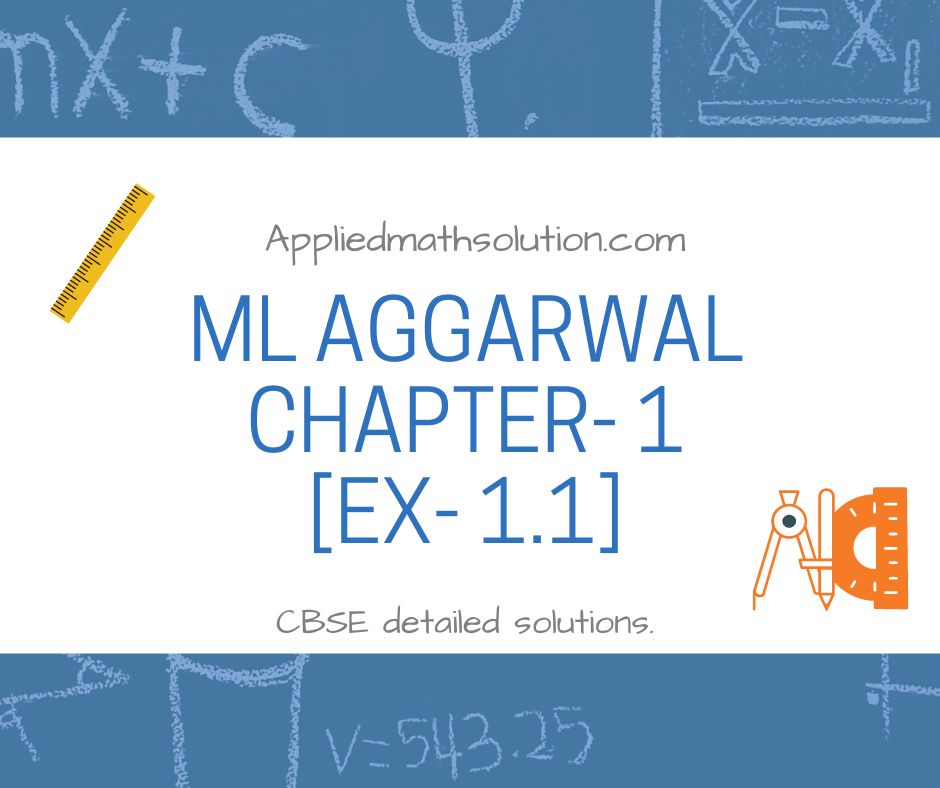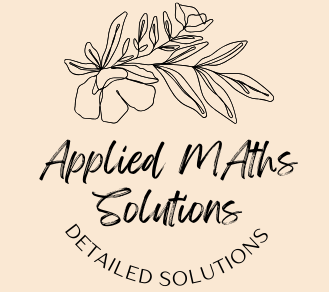Welcome to Class 12 Applied Maths Chapter 1, where we embark on an exciting journey into the world of advanced mathematical concepts tailored for Class 11 students.” Unlock the power of applied mathematics with expert solutions crafted by professionals at AppliedMath.com. Designed to propel students towards academic success, our meticulously curated ML Aggarwal Solutions for Applied Mathematics cater to Class 11 and class 12 students seeking mastery in their examinations. Every query from the CBSE ML Aggarwal Books finds a comprehensive answer on our platform, complete with detailed explanations and step-by-step solutions presented in an easily understandable language.
Dive into the world of applied mathematics and discover how our resources can elevate your understanding and performance. Keep reading to explore the wealth of ML Aggarwal Solutions for Class 11 and Class 12 Applied Mathematics.
Here we provide you with Class 12 Applied Maths Chapter 1, to help you gain a comprehensive understanding of the chapter and its concepts.
https://appliedmathsolution.com/

Class 12 Applied Maths Chapter 1 Solutions
Number, Quantification and Numerical Applications
EXERCISE- 1.1
Q.1 Evaluate the following:
(i) 43 (mod 6)
(ii) 97 (mod 5)
(iii) -17 (mod 4)
(iv) (57 – 42) mod 11
(v) (62 + 53) mod 7
(vi) (9 x 8) mod 5
Ans.
(i) 43 (mod 6)
Dividing 43 by 6 we get 1 as remainder
So, 43(mod 6) = 1
(ii) 97 (mod 5)
Dividing 97 by 5 we get 2 as remainder
So, 97(mod 5) = 2
(iii) -17 (mod 4)
Dividing -17 by 4 we get 3 as remainder
So, -17(mod 5) = 3
(iv) (57 – 42) mod 11
= 15 (mod 11)
Dividing 15 by 11 we get 4 as remainder
So, 15(mod 11) = 4
(v) (62 + 53) mod 7
= 115 (mod 9)
Dividing 115 by 9 we get 3 as remainder
So, 115(mod 9) = 3
(vi) (9 x 8) mod 5
= 72(mod 5)
Dividing 72 by 5 we get 2 as remainder
So, 72(mod 5) = 2
Q.2 Find (576 + 789) mod 9.
Ans.
= 576(mod 9) + 789(mod 9)
= 0(mod 9) + 6(mod 9)
= (0 + 6) mod 9
= 6 mod 9
Hence, 1365 (mod 9) = 6
Q.3 Find (482 x 813) mod 7.
Ans.
= 482(mod 7) x 813(mod 7)
= 6(mod 7) x 1(mod 7)
= 6 x 1(mod 7)
= 6(mod 7)
Hence, (482 x 813)mod = 6
Q.4 Find the remainder when 987 + 876 + 765+ 654 + 543 + 432 + 321 + 210 is divided by 6.
Ans. = 987 ≡ 3 (mod6)
= 879 ≡ 0 (mod6)
= 765 ≡ 3 (mod6)
= 654 ≡ 0 (mod6)
= 543 ≡ 3 (mod6)
= 432 ≡ 0 (mod6)
= 321 ≡ 3 (mod6)
= 210 ≡ 0 (mod6)
Hence,
=(987+876+765+654+543+432+321+210) mod 6
=(3+0+3+0+3+0+3+0) mod 6
=12 (mod 6)
= 0
Q.5 Find the remainder when 862 x 783 x 671 x 549 x 411 x 395 x 217 is divided by 8.
Ans.
= 862 ≡ 6 (mod8)
= 783 ≡ 7 (mod8)
= 671 ≡ 7(mod8)
= 549 ≡ 5 (mod8)
= 411 ≡ 3 (mod8)
= 395 ≡ 3 (mod8)
= 217 ≡ 1 (mod8)
Hence,
= 862x783x671x549x411x395x217 (mod8)
= 6x7x7x5x3x3x1
= 13280 (mod8)
= 6 (mod8)
Q.6. Find the last two digits of the product 4895 x 6789.
Ans.
= 4895×6789 (mod 100)
= 4895 (mod 100) x 6789 (mod 100)
= 95(mod 100) x 89(mod 100)
= 95 x 89 (mod 100)
= 8455 (mod 100)
= 55 (mod 100)
Q.7 Find the last three digits of the product 2345 x 4567.
Ans.
= 2345 x 4567 (mod 1000)
= 2345 (mood 1000) x 4567 (mod 1000)
= 345 (mod 1000) x 567 (mod 1000)
= 345 x 567 (mod 1000)
= 195615 (mod 1000)
= 615 (mod 1000)
Q.8 Find the last two digits of the product 123 x 234 x 345.
Ans.
= 123x234x345 (mod 100)
= 123 (mod 100) x 234 (mod 100) x 345 (mod 100)
= 23 (mod 100) x 34 (mod 100) x 45 (mod 100)
= 23 X 34 X 45 (mod 100)
= 35190 (mod 100)
= 90 (mod 100)
Q.9 Find the value of 6^12 (mod 7).
Ans.
= 6^2 = 1 (mod7)
= (6^2)^6= 1^6(mod7)
= 6^12= 1 (mod7)
= 6^12(mod7) = 1
Q.10 Find the last digit of 17^17.
Ans. 17^17 (mod 10)
17^2 ≡ -1 (mod 10)
(17^2)^8 ≡ (-1)^8 (mod 10)
17^16 ≡ 1 (mod 10)
17^16 x 17 ≡ 1 x 17 (mod 10)
Therefore, 17^17 ≡ 7 (mod 10)
Q.11 Find the last two digits of 2^20.
Ans. 2^20 (mod 100)
2^10 ≡ 24 (mod 100)
(2^10)^2 ≡ 24^2 (mod 100)
2^20 ≡ 576 (mod 100)
≡ 76
Therefore, last two digit is 76.
Q.12 It is 7:00 P.M. currently. What time (in A.M. or P.M.) will be in the next 1500 hours?
Ans. 1500 (mod 24) = 24
1500 hours is equivalent to 24 hours.
7 P.M after 12 hours = 7:00 A.M
Q.13 Find the set of values of x satisfying x + 1 ≡ 32 (mod 7).
Ans. x + 1 ≡ 32 (mod 7)
x + 1 – 32 = 7k
x = 7k + 31
If,
k = 0, x = 31
k = 1, x = 7 + 31 = 38
k = 2, x = 14 + 31 = 45
k = -1, x = -7 + 31 = 24
k = -2, x = -14 + 31 = 17
x = {…..17, 24, 31, 38, 45,….}
Q.14 If 48 ≡ 12 (mod n), find the values of n.
Ans. 48 – 12 is divisible by n,
36 is divisible by n
n = 2, 3, 4, 6, 9, 12, 18, 36
Q.15 If 57 ≡ x (mod 4), find the least positive value of x.
Ans. 57 ≡ x (mod 4)
57 – x = 4k
57 – 4k = x
Q.16 Find the congruence class of 4 mod 7.
Ans. b ≡ 4 (mod 7)
b – 4 = 7k
b = 7k + 4
Q.17 (i) Find addition modulo 7 if a and b are 12 and 6 respectively.
(ii) Find addition modulo 19 if a and b are 8 and 6 respectively.
Ans. (i) 12 + 6 ≡ (12 + 6) mod 7
≡ 18 (mod 7)
≡ 4 (mod 7)
Therefore, the answer will be 4.
(ii) a = 8, b = 6, n = 19
If we add 8 and 6 we get = 14
Since, 14 cannot be divided by 19.
Therefore, the answer will be 14 only.
Q.18 (i) Find subtraction modulo 8 if a and b are 15 and 4 respectively.
(ii) Find subtraction modulo 12 if a and b are 20 and 12 respectively.
Ans. (i) 15 – 4 ≡ (15 – 4) mod 8
≡ 11 mod 4
= 3
Therefore, the answer will be 3.
(ii) a = 20, b = 12, n = 12
If we subtract 12 from 20 we get = 8
Since, 8 cannot be divided by 12.
Therefore, the answer will be 8 only.
Q.19 (i) Find multiplication modulo 8 if a and b are 5 and 7 respectively.
(ii) Find multiplication modulo 6 if a and b are 2 and 3 respectively.
Ans. (i) 5 x 7 ≡ (5 x 7) mod 8
≡ 35 (mod 8)
≡ 3 (mod 8)
Therefore, the answer will be 3.
(ii) 2 x 3 ≡ (2 x 3) mod 6
≡ 6 mod 6
≡ 0
Therefore, the answer will be 0.
FAQ’s related to Class 12 Applied Maths Chapter 12 on Number, Quantification and Numerical Applications:
Q.1 What is the primary focus of Chapter 1 in Applied Mathematics for Class 12?
Ans. The chapter primarily deals with numerical applications like time and work, pipes and cisterns, clocks, calendars, and quantitative estimation. It also includes topics such as numbers and numerical problems in real-life situations.
Q.2 What are the types of numbers covered in this chapter?
Ans. This chapter covers different types of numbers, including natural numbers, whole numbers, integers, rational numbers, irrational numbers, and real numbers.
Q.3 What is Quantification?
Ans. Quantification refers to the process of expressing a numerical value or a quantity. It is often used in mathematical modeling, calculations, and real-life applications like estimating cost, time, or distances.
Q.4 What is the importance of Pipes and Cisterns problems?
Ans. Pipes and cisterns problems are analogous to time and work problems. Here, pipes filling or emptying a cistern at different rates are analyzed. It helps in understanding flow rates and capacities.
These are a few Frequently Asked Questions relating to Class 12 Applied Maths Chapter 1
In Class 12 Applied Maths chapter 1, you will explore fascinating topics that form the backbone of practical problem-solving techniques. Through clear explanations, illustrative examples, and step-by-step solutions, you’ll grasp complex concepts effortlessly. Whether you’re preparing for exams or simply eager to deepen your mathematical understanding, Class 12 Applied Maths Chapter 1 promises an enriching learning experience that will set you on the path to success. Class 12 Applied Maths Chapter 1, we delve deep into advanced mathematical concepts that are crucial for understanding.
Class 12 Applied Maths Chapter 1 EXCERCISES:


